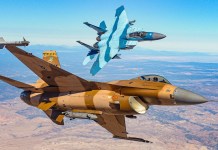In a bid to replace its stellar fleet of F-16 Strike Eagle fighters, the US Air Force is looking for a new fighter jet falling under the 4.5-gen or the 5th-gen with abilities just shy of the Lockheed F-35 stealth fighter.
According to Lockheed Martin – the F-21 jet is specifically configured for the Indian Air Force and provides unmatched ‘Make in India’ opportunities and strengthens India’s path to an advanced airpower future.
The F-21 addresses the Indian Air Force’s unique requirements and integrates India into the world’s largest fighter aircraft ecosystem with the world’s pre-eminent defense company. Lockheed Martin and Tata would produce the F-21 in India, for India.
Originally developed by General Dynamics, the single-engine, supersonic, all-weather multirole F-16 fighter jet has remained the backbone of the US Air Force ever since its first flight in 1974.
However, the USAF is now struggling to maintain an aging fleet of fighters and there is a need for a more advanced aircraft to provide support to the F-35 and F-22 Raptors. Keeping this in view, the US military is looking for something more than what is offered by the air superiority fighter.
Air Force Chief of Staff General Charles Q. Brown Jr. is now launching a months-long study into the US Air Force’s future force mix. This will include a “clean-sheet design” to replace the F-16 fighters. There is also a possibility of a change in the earlier plans of procuring 1,763 units of the fifth-generation F-35A.
The Air Force Chief, while speaking at the Defense Writers Group, brought forward his idea for developing a new “four-and-a-half-gen or fifth-gen-minus” fighter to supersede the F-16 Viper, the most advanced variant of the F-16 fighters.
Brown, a former F-16 instructor pilot, said he was launching the study that is in sync with the US Department of Defense’s Cost Assessment and Program Evaluation (CAPE), on the service’s future mix of tactical aircraft.
According to reports, the tactical aircraft or TacAir study will be one proposal under investigation as the US Air Force goes ahead to assess the optimum balance required for its tactical fighter force.
Moreover, it will run simultaneously with Washington’s Cost Assessment and Program Evaluation (CAPE).
“This will help inform the decisions that I think I need to make internal to the Air Force, and what I would recommend that force mix might be,
“Now, I will also tell you I don’t think that everybody’s going to exactly agree with what I say. But I want to actually have a starting point as a point of departure, a point of dialogue,” said Brown.
The Air Force Chief stressed the need for the study to be done with the help of CAPE so that the Office of the Secretary of Defense (OSD) can have a say before the decisions are made by the US Air Force.
“Naturally if I just do the Air Force study, it’s just an Air Force study,” said Brown. He also mentioned how the input provided by OSD will enable the TacAir study to inform Defense Secretary Lloyd Austin’s new global force posture study.
“I think the dialogue back and forth between the two will help shape the Global Posture Review; at the same time, the Global Posture Review will help shape our TacAir study based on the priorities the department has laid out,”
“I don’t want to do my TacAir study in a vacuum. It would be naive of me to do that,” said Brown.
The Air Force Chief hopes that the force mix study can be completed in time to inform decisions for the US Air Force’s Fiscal Year 2023 budget request.

“In the budget for FY 23, that’s where I see that we’ll really make some key decisions,” said Brown.
Earlier, outgoing Assistant Secretary of the Air Force for Acquisition, Technology, and Logistics, Will Roper, had suggested that the Block 70/72 version of the F-16 fighter could be one of the alternatives for enhancing US Air Force’s tactical fleet.
However, Brown does not share the same opinion and believes that the advanced Viper version is not the answer that the US Air Force is looking for, in terms of the future.
The F-16 Viper’s inability to receive software updates at the speed that is needed and its lack of open-architecture software protocols are some of the reasons why Brown feels that the variants are not up to the mark.
According to Brown, he would want a new fighter to feature “open-mission systems”, which is something that the Air Force has been testing in live flying scenarios that involve manned aircraft.
The open architecture design will enable the new fighter jet to receive software updates in rapid succession, potentially even during a mission.
Instead of the Viper, the US Air Force would rather consider manufacturing a fighter that is faster and different than the F-16s, Brown said.
“(It should be) something new and different, that’s not the F-16 — that has some of those capabilities but gets there faster and uses some of our digital approaches,” added Brown.
Follow EurAsian Times on Google News




